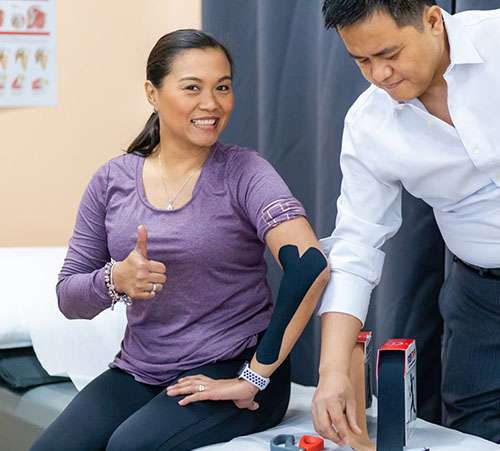Most Common Neck Conditions
-
Cervicalgia
Cervicalgia is a pain or discomfort in the neck. The common cause is poor posture due to constant strain in the muscles, so as a bad sleeping position. Injury to the neck also leads to neck symptoms.
Signs & Symptoms
-
1. Neck pain.
-
2. Muscle spasms.
-
3. Stiff & tight neck
-
4. Tenderness in the upper back muscles
-
5. Headaches
The Key to Recovery
-
1. Reduce inflammation.
-
2. Mobilize the neck.
-
3. Relieve muscle spasms.
-
4. Strengthen muscles of the neck & upper back.
-
5. Correct Posture.
Cervical Spondylosis
Cervical spondylosis is a condition causing neck pain due to the degeneration of the cervical spine. It may be due to wear and tear or injury. As a result, the disc loses its fluid and affects the joints and nerves in the spine.
Signs & Symptoms
-
1. Neck pain and headaches.
-
2. Muscle spasms.
-
3. Stiff neck.
-
4. Cracking sensations.
-
5. Increase pain with head movement.
The Key to Recovery
-
1. Reduce symptoms.
-
2. Light exercise to the joints to loosen stiff neck.
-
3. Strengthen weak muscles.
-
4. Stretch tight tissues.
-
5. Improve posture.
Cervical Radiculopathy
Cervical radiculopathy occurs when a nerve root in the neck is compressed. It often starts when a disc in the spine goes out of place and begins touching a nerve. The squeezed nerve leads to pain that radiates to the arm or scapular area. We call this a pinched nerve.
Signs & Symptoms
-
1. Neck pain shoots to the arm to hands.
-
2. Neck & upper back spasms.
-
3. Weakness of the arm muscles.
-
4. Numbness or loss of sensation in the arm and hand.
-
5. Increase symptoms with neck movement.
The Key to Recovery
-
1. Relieve symptoms with modalities.
-
2. Medications to reduce inflammation.
-
3. Loosen and stretch tight muscles.
-
4. Strengthen neck muscles.
-
5. Correct posture.
Neck Myofascial Pain
Neck myofascial pain is a painful condition due to tight fascia and muscles. The fascia is a tissue that covers the muscles and provides support. When tight, it chokes the tissues and leads to constant spasms. It is brought about by stress, overuse, or injury to the neck.
Signs & Symptoms
-
1. Neck pain and soreness.
-
2. Deep muscle spasms.
-
3. Presence of knots and trigger points in the muscles.
-
4. Disturb sleep and sore waking up in the morning.
-
5. Increase in symptoms with activities.
The Key to Recovery
-
1. Relieve symptoms with modalities.
-
2. Release trigger points and loosen knots.
-
3. Stretch fascia.
-
4. Strengthen weak muscles.
-
5. Improve posture.
Tension headache
Tension headache is a tightness and dull pain of the head muscles. It caused by spasms and increased the sensitivity of muscles in the head and neck. Sometimes, people think it’s a migraine when only one side is affected.
Signs & Symptoms
-
1. Headaches.
-
2. Feeling of tightness at the head.
-
3. Tenderness in the neck and scalp muscles.
-
4. Muscle weakness.
-
5. Postural issues.
The Key to Recovery
-
1. Reduce symptoms.
-
2. Release trigger points and loosen the fascia.
-
3. Strengthen weak muscles.
-
4. Correct posture.
-
5. Regular exercise.
The Right Care Approach For Your Situation
-
-
Protective
CareOur approach to care is to protect your injury or surgery. We focus on stopping more damage to your tissues and start the healing process.The ideal method of care when you can't function due to pain and weakness. You still depend on others fully to meet your needs.Our treatment is to protect, rest, ice, compress, and elevate the injured tissue with your prescribed meds. We will also teach you home remedies.Our goal is to kick-start your recovery and prevent secondary problems. We want you to heal at the expected time.
-
-
-
Gentle
CareOur approach to care is gradual when your condition is stable but painful. Then, we focus on faster healing of your tissues and recovery of function.The ideal method when your pain is bearable, but the movement is limited. Besides, you show difficulty performing self-care and daily routine.Our treatment is heat or cold, ultrasound, and TENS combined with massages. You will start with pain-free exercises to improve your functions.Our goal is to accomplish your daily needs with no assistance. We will prepare you to regain your primary activities.
-
-
-
Progressive
CareOur approach to care is aggressive when you need to regain normal function. Our focus is training related to your daily work and active life.The choice of care when performing your daily duties is still challenging. You still have an increase in pain with increasing activities.Our treatment includes manual therapy to deal with spasms and tightness. Then, we prescribe exercises and targeted work-outs to a balanced posture.Our goal is for you to perform daily duties and hobbies without pain. Moreover, we will guide you to improve your strength without difficulty.
-
-
-
Enhance
CareOur approach to care is to maximize your performance in sports. Therefore, we focus on specific training to boost your skills in a game.The perfect method when you need to optimize your skills. It will be best to refine your balance, agility, and posture to perform better in sports.Our treatment includes taping and manual therapy to activate muscle action. In addition, you practice targeted training for specific game skills.Our goal is for you to perform well in sports and enjoy your hobbies. Thus, we will help maximize your performance in your game.
-

Physical Therapy Method of Care
Our treatment is based on the proven method of physical therapy. We use techniques tested to help our patients recover and live pain-free.
For more than 20 years of experience, the methods and healing process is almost the same for each patient. But our approach depends on their issues. Besides, we treat patients as a human, not a body part.
Our best experience for recovery is to give proper care. We have to feel what our patients feel and understand their concerns. Only then we provide the best care.
At CT Physical Therapy Care, our happiness is to give you a 5 Start experience!

Contact Us
"*" indicates required fields
-


